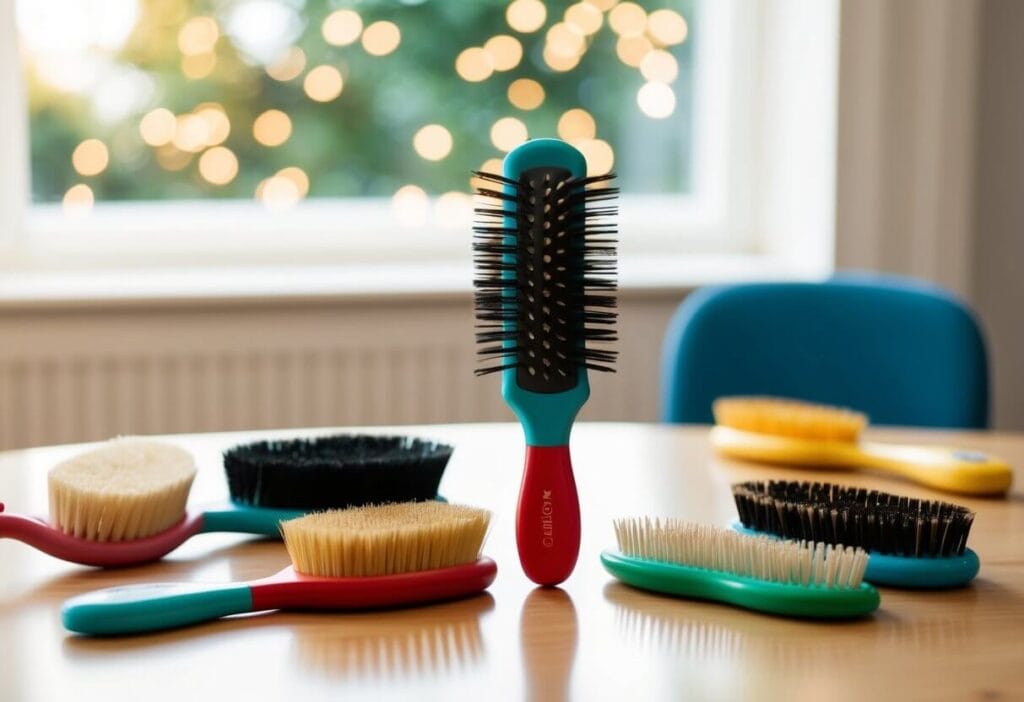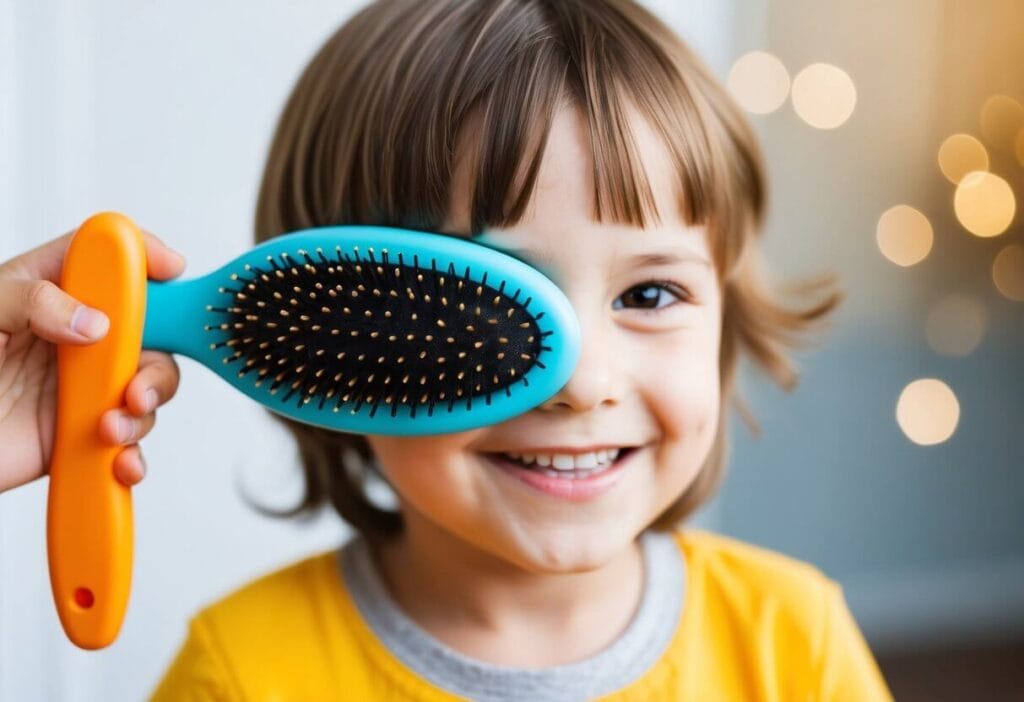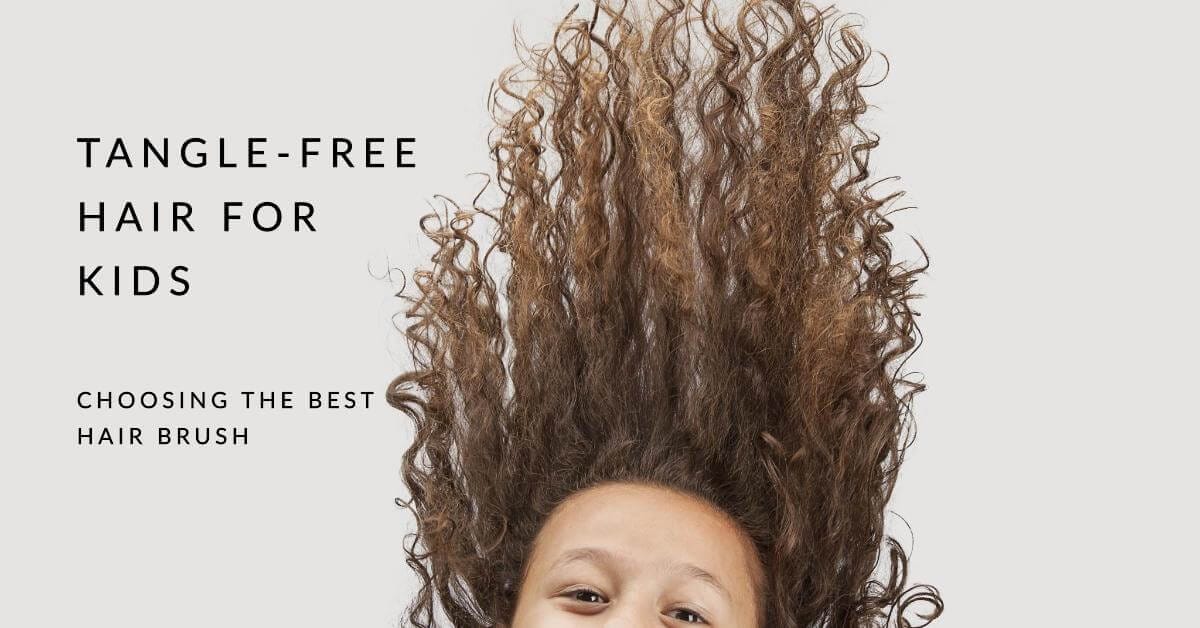Choosing the right hair brush for a child can make the daily routine of hair care much easier and enjoyable. Brushes designed specifically for kids often come with features like soft bristles and fun designs, making the experience more pleasant for both parents and children. These brushes not only ensure gentle detangling but also protect delicate scalps from damage.

A good hair brush can help manage different hair types, whether curly, thick, or fine. Understanding a child’s specific hair needs is crucial for selecting the best brush. For instance, a detangling brush is ideal for tackling knots without causing pain or discomfort, while a soft-bristled brush might be perfect for a baby’s fine hair. The right brush simplifies the task of maintaining a neat and healthy hairstyle.
When shopping for a kids‘ hair brush, consider factors like ease of use, the comfort of the handle, and durability. There are many available options ranging from pocket-sized brushes for on-the-go styling to larger ones suitable for home use. Additionally, look for features like non-scratch bristles that minimise breakage and air-cushioned heads that are gentle on the scalp.
On This Page
Key Takeaways
- Choosing the right brush eases hair care for children.
- A suitable brush helps manage various hair types.
- Features like soft bristles prevent scalp damage.
Types of Hair Brushes for Kids
Choosing the right hairbrush for kids is important to keep their hair healthy and manageable. Different types of brushes can handle tangles, add smoothness, or work with various hair types, making every hair care routine more effective.
Detangling Brushes for Tangled Hair
Detangling brushes are excellent for managing tangled hair in kids. These brushes often have flexible bristles that can gently glide through knots without pulling or causing discomfort.
A popular option is the Crave Naturals Glide Through Brush, known for its unique cone-shaped bristles. Unlike traditional brushes, it works sideways to ease out even the toughest knots, making the detangling process quicker and less painful for children.
These brushes can be particularly beneficial for kids with curly or long hair, where tangles are more common. They’re also a great way to avoid tears and tantrums during hair brushing routines.
Boar Bristle Brushes for Smoothing
For smoothing out hair, boar bristle brushes are a fantastic choice. These brushes are known for distributing natural oils from the scalp through the hair, adding shine and reducing frizz.
The bristles are typically softer and can help in smoothing the hair surface by closing the cuticle layer, which reduces puffiness and enhances the hair’s overall health.
For fine or straight hair types, boar bristle brushes are particularly effective at maintaining a sleek appearance. This makes them an essential tool in a kid’s hair care kit if the goal is shiny, smooth hair.
Comb Sets for Various Hair Types
Comb sets are versatile tools that cater to different hair types and styles. They often include a range of combs designed for tasks like detangling, making precise parts, and styling various hair textures.
Combs with wide teeth are great for detangling, while finer combs are useful for creating neat styles or managing straight or wavy hair.
Having a set allows parents to choose the right tool for their child’s specific hair type, whether it’s thick, thin, curly, or straight. This adaptability makes comb sets a valuable addition to maintaining healthy and styled hair in kids.
Selecting the Right Brush for Your Child’s Hair Type

When choosing a hairbrush for children, consider the hair type and specific needs, like length and wetness. The right brush can prevent damage, reduce tangles, and make brushing a more pleasant experience.
Brushes for Long Hair
Long hair can tangle easily, so selecting a brush that prevents snags is important. A paddle brush with wide-set bristles is effective for smoothing long hair without pulling. Natural bristle brushes are gentle and help distribute natural oils from the scalp to the ends.
For children with fine or wavy long hair, a brush with softer bristles can reduce breakage. Bristle combinations (natural and synthetic) are ideal for detangling and maintaining healthy hair. Ensure the handle is comfortable to hold, especially for longer brushing sessions.
Brushes for Wet or Dry Hair
When dealing with wet or dry hair, versatility in a brush is key. The Tangle Teezer is excellent for both conditions, as it smoothly detangles without tugging. Vent brushes are designed for faster drying, making them suitable for everyday use.
Brushes with flexible bristles are important for wet hair to avoid breakage. For dry hair, choosing a brush that reduces static can prevent frizz. Look for a brush with an ergonomic handle to enhance control and ease.
Benefits of Using the Right Hair Brush

Choosing the right hair brush for kids can make a significant difference in maintaining healthy hair and making daily routines smoother. The right brush caters to specific needs, such as detangling and ease of styling.
Hair Health and Detangling
Using the correct hair brush helps protect a child’s hair from damage. Brushes with soft, natural bristles, like boar or wool, are gentle on delicate strands. This prevents hair breakage and split ends. A quality detangling brush can also make the process of removing knots less painful.
Well-designed brushes can effectively detangle without pulling. This reduces the risk of crying episodes and keeps hair tangle-free. Brushes with cone-shaped bristles, such as the Crave Naturals Glide Through Brush, are known for taking on tough tangles gently.
Ease of Styling and Daily Use
Having the right brush can simplify a child’s morning routine. Brushes with mixed bristles, combining nylon and natural fibres, are versatile and suitable for various hair types. They make styling quicker and more efficient.
A lightweight and ergonomic design makes it easy for kids to brush their hair independently. Personalised options can even make grooming fun. For parents, the right tool minimises stress during busy mornings, ensuring the day begins smoothly.
Shopping for Kids Hair Brushes
When shopping for kids’ hair brushes, it’s essential to consider brand choices, unique handcrafted options, and seller ratings. These factors help in choosing a brush that’s effective and enjoyable for children.
Considerations of Medium Business Brands
Medium-sized business brands offer a variety of kids’ hair brushes. These brands often focus on quality materials and design that cater to children’s needs. They strive to balance affordability with high standards, providing brushes that gently detangle both curly and straight hair.
Parents might find brushes with features such as cushioned heads and non-scratch bristles, ensuring a comfortable experience. Lily England, for example, offers vegan detangling brushes suitable for kids and toddlers. Shopping from these brands can support a sustainable and ethical marketplace.
Finding Artisanal and Personalised Options
Artisanal hair brushes offer unique, handcrafted options that often incorporate fun designs to appeal to kids. These brushes may feature colourful patterns or favourite characters, making hair brushing a more enjoyable activity for children.
Personalised tips can include adding a child’s name or choosing a specific theme. These special touches can encourage a positive attitude towards personal grooming. While artisanal options may come at a higher cost, the customisation and creativity they bring can be well worth it.
Understanding Seller Ratings
Seller ratings provide insight into the quality and reliability of both the product and the seller. High ratings typically indicate a good history of customer satisfaction and product quality. Shoppers are encouraged to read reviews and check ratings before purchasing.
Platforms like Amazon feature ratings on product pages, where consumers can share experiences about the hair brush’s effectiveness and durability. Consider looking for brushes with multiple positive reviews, as these are more likely to meet expectations for performance and kid-friendliness. Clear, honest feedback can guide the decision-making process, ensuring the best choice for the child’s hair care routine.
Additional Considerations
When looking for a hairbrush for children, several important aspects should be considered. Paying attention to colour preferences can make the brushing experience more enjoyable. Exclusive offers and unique gifts provide creative purchasing options. For those in Germany, understanding specific market needs can be advantageous. Related searches can also help consumers find comprehensive shopping options.
Colour Preferences in Kids Hair Accessories
When choosing a hairbrush for kids, colour often plays a significant role. Children may have specific favourite colours like pink or blue that can make a hairbrush more appealing and fun. Bright colours and playful designs can make the daily routine of brushing hair more exciting and less of a chore for youngsters.
A child’s preference can even be influenced by their favourite cartoons or characters. Look for hairbrushes that feature popular themes like animals, space, or fairy tales. Matching hair accessories, such as clips or bands, in the same colour scheme can enhance the overall appeal and make the process more engaging.
Exclusive Offers and Unique Gift Ideas
Finding exclusive offers can make purchasing a children’s hairbrush more budget-friendly. Many retailers offer bundles, where a hairbrush is sold alongside other hair care products like detangling sprays or hair clips. These can be cost-effective and an excellent way to try multiple products.
For unique gift ideas, consider personalising the hairbrush. Personalisation options, such as engraving a child’s name, can turn a simple hairbrush into a special keepsake. Special edition brushes featuring favourite characters or limited colours and patterns can also serve as unique presents for birthdays or special occasions.
Considerations for German Markets
The German market for children’s accessories has its own unique considerations. Trust and quality are essential, so parents often look for products that adhere to high safety standards. Brushes made from eco-friendly materials or with certifications might attract eco-conscious consumers.
Customs and preferences in Germany may include a preference for natural materials, like wooden brushes, which offer a more traditional feel. Accessibility of these products in local stores and online platforms might also be crucial, with many opting for German brands or those that ship reliably to Germany.
Identifying Related Searches for Comprehensive Shopping
Understanding related searches can help buyers discover a range of products and options. Common related searches include “detangling brushes for kids” or “soft bristle hairbrushes for children.” This can guide families to specific types of hairbrushes that meet their individual needs.
Shoppers might also look into platforms like Etsy, where handmade or custom hairbrushes are available. Using related search terms can uncover less common options or innovative designs not found in major retail chains. This breadth of choice helps to ensure everyone can find a hairbrush that suits their child’s needs perfectly.
Frequently Asked Questions
How do I brush my 3-year-old’s hair?
Start by using a soft-bristle or detangling brush made for toddlers. It’s important to be gentle, especially if they have fine or sensitive hair. Here’s a step-by-step approach:
1. Start at the tips: Begin by brushing the ends of the hair, then work your way up to avoid pulling or causing discomfort.
2. Hold sections: Hold sections of hair near the scalp to reduce tugging on the roots.
3. Distract and engage: Make brushing fun by using songs, a favourite toy, or even a mirror so they can see the process.
How do I get my 7-year-old to brush her hair?
At age 7, children can begin learning to care for their own hair with supervision. Encourage independence with these tips:
1. Make it a routine: Set up a hair care routine each morning or after baths.
2. Offer choices: Let them choose their own hairbrush or accessories like detangling spray or headbands.
3. Teach technique: Demonstrate how to brush from the ends upward and explain why it’s important to avoid knots.
4. Positive reinforcement: Praise them for brushing on their own, even if they need a little help along the way.
How do you brush an autistic child’s hair?
For autistic children, brushing hair can sometimes be overwhelming due to sensory sensitivities. Here are a few strategies to help:
1, Desensitise gradually: Introduce brushing slowly, starting with just a few strokes per day.
2. Use a sensory-friendly brush: Opt for a brush that is gentle, like silicone-tipped or soft detangling brushes.
3. Incorporate their preferences: Use their favourite products or let them hold the brush while you help.
4. Offer breaks: If the child becomes uncomfortable, take short breaks to avoid sensory overload.
Should you brush toddlers’ hair?
Yes, it’s important to brush toddlers’ hair to prevent tangles, especially if they have longer hair. Use a soft, toddler-friendly brush, and be gentle to avoid discomfort.
How to brush kids’ hair without it hurting?
Here are tips to make brushing painless:
1. Use detangling spray: This will make the process smoother by reducing friction.
2. Brush in sections: Start at the bottom of the hair, holding the section to avoid pulling on the scalp.
3. Choose the right brush: Use a wide-tooth comb or a detangling brush designed for children’s hair.
How often should you wash a 3-year-old’s hair?
For most toddlers, washing hair 2-3 times a week is sufficient. Over-washing can dry out their scalp, while under-washing might lead to build-up. Adjust the frequency based on your child’s activity level and hair type.
Is it OK to brush baby’s hair?
Yes, you can brush a baby’s hair, but use a very soft-bristle baby brush. It helps distribute natural oils and prevents cradle cap. Brushing also stimulates the scalp and helps babies relax.
At what age can you start combing a baby’s hair?
You can start combing or brushing a baby’s hair as soon as they are born. Just ensure the brush or comb is gentle and designed for newborns.
Is it good to wash baby hair every day?
It’s not necessary to wash a baby’s hair every day. For most babies, washing their hair 2-3 times a week is enough to keep their scalp clean. Daily washing can dry out their delicate scalp.
Why do I have frizzy baby hairs?
Frizzy baby hairs, also known as flyaways, are usually new, fine strands of hair that haven’t fully grown out yet. They can appear frizzy due to:
1. Humidity: Moisture in the air can make short hairs frizzier.
2. Hair texture: Fine or curly hair types are more prone to frizz.
3. Damage or breakage: If hair is damaged from heat styling or brushing, the new growth may appear frizzy.

